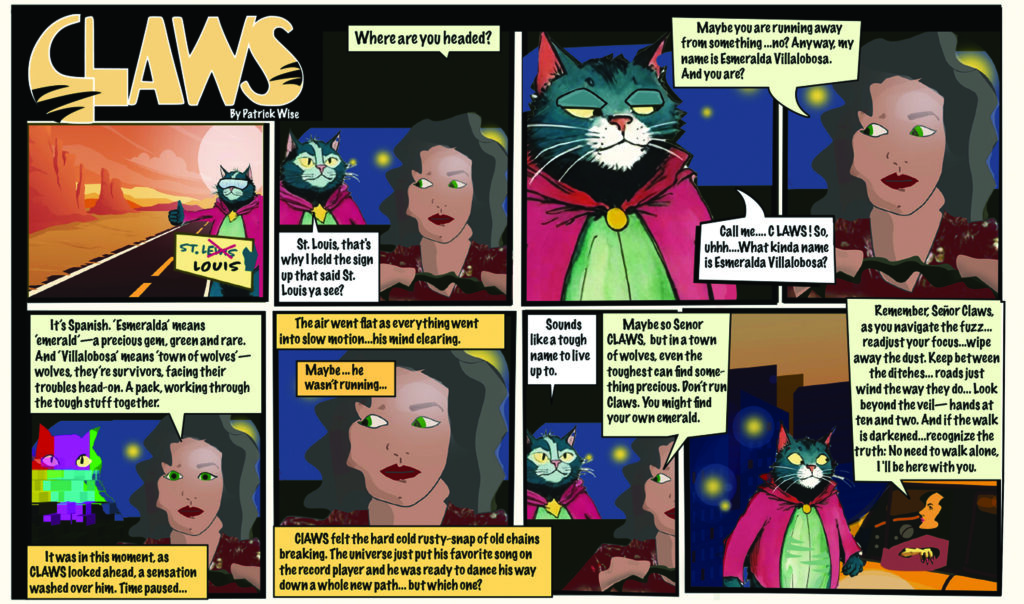As a kid, I couldn’t pay attention to the reality of the classroom’s chalkboard world. My pencil was always scribbling from its warped source of reality, fueled by hours and hours of maniacal Saturday morning cartoons—a happy place vividly logged under nostalgic memories in the farther recesses of my data banks.
Back in the day, my friends and I plagiarized schoolbooks with pencil speech bubbles, making John F. Kennedy, Winston Churchill, or whoever else the star of our imaginations. This gateway to ingenuity opened all sorts of ideas in my head, so I got the big idea to start erasing the text from the speech bubbles of comic strips, inserting my versions, and then passing the resulting take around the classroom among my friends. Many years later, I’ve found a similar vent: “Garfield Minus Garfield.”
“Garfield Minus Garfield” is twice as funny as the original “Garfield.” I wish I had this comic when I was reading the original. The popular webcomic by Dan Walsh, which quickly became a viral sensation, was first published in 2008. This version of “Garfield”offers a noticeably more jarring perspective of the fat, lasagna-eating, cynical, smart-mouthed Garfield—namely, that he’s not there. The comic uses the original Jim Davis Garfield strips but digitally removes Garfield (and sometimes other characters) from the scenes. The resulting images are left with only Jon Arbuckle’s actions and expressions, creating a surreal and existential portrayal of his life without Garfield’s presence. It shifts the focus to Jon’s solitude and the absurdity of his interactions—no Nermal, no Odie, no Argyle, etc.
In November 2008, an official version of “Garfield Minus Garfield” was launched on GoComics by Paws Incorporated. The comic, with its alt-sampled angle art form, hailed by Jim Davis as “Inspired,” became unstuck from its time and landed in perfect synchronicity with the digital age and its new platforms. “Subtraction art” is where elements are deliberately removed from an original work to uncover new interpretations. In “Garfield Minus Garfield,” the Garfield-less comic leaves Jon alone, providing a skewed perspective that now appears to depict an insane person. Without his pet partner in crime, what is left is Jon, who seems to struggle with existential issues and loneliness. This removal transforms the comic from lighthearted humor into a profound commentary that analyzes deeper emotional aspects of his life.
Without Garfield, Jon’s character is out of step with reality. He is isolated, bored, and frustrated. His life feels repetitive and empty, which mirrors the struggles many people face today, like feeling disconnected or stuck in a routine. This makes the comic relatable to modern readers who deal with loneliness and the pressures of daily life. Jon’s constant interactions with empty space show how his loneliness is a reflection of larger, real-world feelings of alienation.
“I was astonished at how horrifically dark they could be,” Walsh told Cracked.com in 2023.
Before the introduction of “Garfield Minus Garfield,” there were other variations of the comic, such as “Garfield Minus Garfield’s Thoughts” and “Realfield,” where Garfield was either absent or replaced with an anthropomorphic cat. The appeal of such a “bootleg” remix correlated with growing meme culture and the ready-to-go formats easily replicated from the web. It marks a cultural shift away from traditional DIY art approaches. Remix art resonates now because it allows creators to reinterpret familiar works in new and unexpected ways. It reflects the digital age’s accessibility to image formats, resulting in an interconnected collaboration. It’s innovative in the way rap was when beats were made by remixing records. In a time when information and art are constantly shared and altered, remixing allows new meanings to emerge from the old.
As I look back and remember my scribbles, I sometimes reflect nostalgically. Garfield is a direct link to the smell, sight, and sound of the innocence of youth circa 4th and 5th grade elementary school. I devoured every book, just like Garfield devoured lasagna. At the time, I remember the comic’s art having the perfect angle on some form of comedic approach that was unique in its time. That angle can be attributed to the “Late Show withDavid Letterman” and “Saturday Night Live.” Garfield’s sarcastic view on life and his actions among his household acquaintances was so fresh that it always made me laugh. My best friend and I would redraw them and share them in school the next day, and it felt as if we were the special select few who were privy to this unique format, which resonated deeply. That view is remembered in Walsh’s new version. Still, it has evolved into a more grotesque detachment, reflecting how revisiting nostalgic memories rekindles a fondness for the past but somehow leaves a bittersweet taste, as you can never really go back. “Garfield” has left the page, and I don’t exactly erase the speech bubbles and pass the updated edits around the classroom anymore… but in my mind, I do.
Pat Wise is a comic artist and graphic designer at the Mountain Times.





